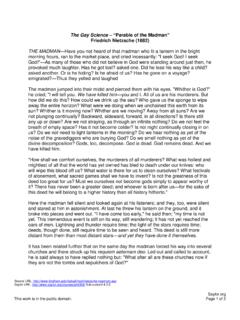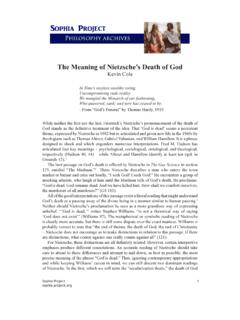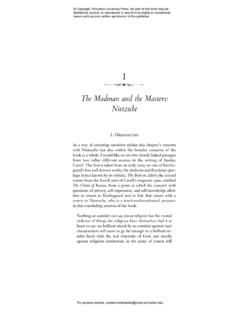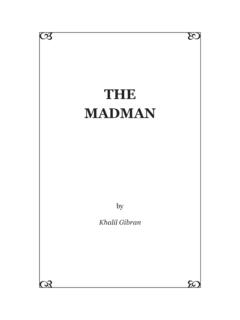Transcription of Madman: Strange Adventures of a Psychology Intern
1 Instructor Teaching Packet for madman : Strange Adventures of a Psychology Intern by John Suler, Thanks for adopting madman for your course. In this packet I will offer some ideas on how to integrate the novel into your classroom activities. In these descriptions, I will refer to my website Teaching Clinical Psychology which contains a wide range of resources. You can find it easily via google. madman and my Teaching Clinical Psychology site concentrate on issues concerning mental health and illness, counseling, psychotherapy, interpersonal relationships, and personal growth, which applies not just to clinical courses, but many other courses as well. Some of the activities below focus specifically on my novel, while others use madman as a springboard to other learning experiences described in my Teaching Clinical Psychology site. CONTENTS: 1. Discussion Questions What s it like to be a psychotherapist? After reading the novel, do you think you would want to be a mental health professional?
2 What s life like on a psychiatric unit? What are the roles of the various mental health professionals (psychiatrists, psychologists, social workers, psychiatric nurses)? How do these professionals relate to each other? What s your psychological analysis of Thomas Holden? What s more important: biology or Psychology ? Is the madman a therapist, or is the therapist a madman ? What are the limits of Psychology and science? What s reality and what s fantasy in the novel? What about all those loose ends? 2. Activities and Exercises Identifying Mental Disorders and Personality Types The Intake Interview and Mental Status Exam Mental Health Treatments Defense Mechanisms Secrets and Resistance in Psychotherapy Cognitive Distortions Transference Reactions and the Shadow Childhood Memories Understanding Sleep and Dreams Personal Timelines Computerized Psychotherapy Eastern Philosophy and Western Psychology Using the I Ching for personal insight and change Transcendent, Peak, and Spiritual Experiences The Training of the Psychologist and Psychotherapist 3.
3 Images for Teaching 4. Web Addresses 1. Discussion Questions What s it like to be a psychotherapist? Many students comment that they have read about or seen movies and TV programs about psychotherapy from the perspective of the client. But now they are able to envision how the psychotherapist feels about it? What are the pros and cons of doing this type of work? Did students gain some new insights into the inner thoughts of the psychotherapist? After reading the novel, do you think you would want to be a mental health professional? Discuss with students what inspired them about the novel, and what might have given them pause for thought about becoming a mental health professional. What indeed are the rewards as well as the stresses? I wrote madman to give my students a realistic glimpse into the lifestyle of a psychologist working on a psychiatric unit. After reading it, many students feel inspired to become a mental health professional.
4 Others are not so sure, usually because they think the work might involve too much responsibility and stress. I remind students that I exaggerated the pressures experienced by the Intern Thomas Holden in order to create a dramatic story. A mundane workday of the typical psychologist wouldn t work well as a novel! Nevertheless, being a psychotherapist is a complex professional career and can sometimes be stressful. What s life like on a psychiatric unit? madman is a realistic depiction of life on a psychiatric unit. Encourage students to discuss the purpose of the various activities on the unit, like morning report, intake interviews, community meetings, and grand rounds as well as how the structural design of the unit affects the patients and staff ( , center circle, isolation rooms, interview cubicles). Encourage students to discuss how the environment in madman differs from the usual Hollywood versions of the mental ward.
5 How do private, state, and teaching hospitals differ? Some of the students in your class might have visited or worked in psychiatric hospitals. Ask them about how those places compared to the hospital in madman . What are the roles of the various mental health professionals (psychiatrists, psychologists, social workers, psychiatric nurses)? How do these professionals relate to each other? Undergraduate students might know very little about the differences in training and professional responsibilities among the various mental health professionals. Graduate students might know very little about the politics of the profession. Encourage them to discuss what they learned about these issues from madman . What happens in other hospitals and clinics might be very different. How so? What s your psychological analysis of Thomas Holden? The story unfolds through the eyes of the Psychology Intern , Thomas Holden.
6 Ask students what it was like living in his shoes. How would they describe his personality, motivations, self concept, and conflicts. This is a coming of age novel, so what psychological transformations are occurring in Holden? What causes him to fall apart, and then recover? What s more important: biology or Psychology ? During the novel Holden often ponders this question about whether biological or psychological factors weigh more heavily in determining human behavior, and whether biological or psychological treatments for psychological problems work best. What are the arguments made in the novel about this issue? What do your students think about this topic and what conclusions can be drawn from psychological research? Is the madman a therapist, or is the therapist a madman ? The title of the book suggests that someone is a madman . But who? Obviously, some of the patients, but what about Doe? Is he really mentally disturbed?
7 How do we define normal and abnormal? And what about Holden himself, who seems to be decompensating during the course of the novel? The relationship between Doe and Holden addresses this interesting question about who s the therapist and who s the madman . Might Doe be a wise but quirky old man, maybe even a kind of Zen master, who is trying to help Holden? If so, how is he trying to help Holden? Encourage students to talk about those situations in which psychotherapists might be the madman while the clients might be the therapists. Issues about countertransference and mental health problems among psychotherapists will be important in this discussion. What are the limits of Psychology and science? Throughout the novel, Holden questions just how much we can know about the human mind using the traditional approaches of Psychology and science. What do students think about this question? Encourage them to talk about whether Psychology and science can solve problematic issues concerning morality and spirituality.
8 There are elements of eastern philosophy that surface throughout the novel, and eastern philosophy claims that reason and rationality have their limits. What do your students think about that? What s reality and what s fantasy in the novel? As a person who enjoys movies and books where reality blends with fantasy (in such movies as The Matrix, Total Recall, and Vanilla Sky), I wrote madman in this style. Encourage students to discuss these ambiguities for example, how it s hard to determine when Holden is awake or dreaming, and how at times he seems to be hallucinating. Where do his thoughts and journal entries end, and where does reality begin? These ideas can lead to interesting discussions about how the distinction between reality and fantasy is not always as clear as we might think. When and how is reality psychologically constructed by the mind? What about all those loose ends? Students often comment about the loose ends at the conclusion of the novel.
9 What happened to Doe, the journal, and the woman in the cafeteria? I intended the story to be somewhat open ended and therefore open to a kind of projective test. Ask students what they think about Doe, the journal, and the woman. Tell them there are no right or wrong answers, but instead only answers that reflect their own attitudes and beliefs. The students will surprise you with some very interesting ideas! (Note: in the last chapter there is a hint that the woman in the cafeteria reappears. Some students are pleased to see that) 2. Activities and Exercises Identifying Mental Disorders and Personality Types Several types of mental disorders are portrayed in the novel, including paranoid schizophrenia (Richard Mobin and Rachael Finski), a borderline personality disorder (Cheryl), a cognitive disorder (Mr. Tennostein), depression (Elizabeth Baso), and an impulsive disorder (Kathy Mummon). There are also a variety of personality types illustrated, such as narcissistic (Dr.)
10 Stein), compulsive (Fred Cooling), schizoid (Dr. Lloyd), schizotypal (Jon), and passive aggressive (Ron). Ask students to apply DSM criteria to the mental disorders portrayed in the novel. Ask them to identify the features of the various personality styles using either DSM criteria for personality disorders, or the reinterpretations of those criteria as personality styles (as in David Shapiro s book Neurotic Styles or Nancy McWilliam s Psychoanaltyic Diagnosis). For spin off activities, see the exercises Diagnosing Mr. Smith, Shades of Abnormality and Personality Disorders in the In Class Exercises section of my Teaching Clinical Psychology website. The exercise on personality disorders includes a handout that summarizes the features of these disorders. The Intake Interview and Mental Status Exam During the novel we see Thomas Holden conducting an intake interview and mental status exam. Ask students to identify the types of information a clinician tries to obtain during the intake interview, and the kinds of mental functions that are assessed in the mental status exam.









